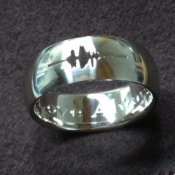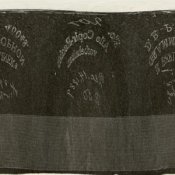video included
http://www.usatoday.com/story/news/nation/2013/07/22/professor-plays-photo-vintage-vinyl/2574615/
Music historian unlocks sounds from 1889 record engraving.
STORY HIGHLIGHTS
Professor turned photo of one of the earliest gramophone records into a sound recording
The recording captures the voice of Emile Berliner, the German-born American father of the gramophone
Feaster is co-founder of an organization aiming to uncover the earliest sound recordings available
While exploring the fourth floor of the Indiana University-Bloomington library, IU music historian Patrick Feaster was pleasantly surprised to stumble across a photograph of vintage vinyl in an old German magazine.
The photo showed one of the earliest gramophone records, "Der Handschuh." Feaster excitedly scanned a copy of the photo to take home.
Two months later, in a technological breakthrough heralded by early-music experts, Feaster played the scanned piece of paper, which has become the oldest gramophone recording available today.
The recording spins back to the days of 1889 and captures the voice of Emile Berliner, the German-born American inventor and father of the gramophone, trying out his latest invention.
The photo of the record in the magazine was an advertisement, showing consumers what the new technology of the day would look like, Feaster said. Although the photo was used for marketing purposes, the image also showed the grooves of the record, giving Feaster the opportunity to play it more than 124 years later.
In order to convert the picture into sound, Feaster scanned the photo and then, using photo-editing software, straightened the round lines, or grooves. As he zoomed in close, the grooves turned into cardiac-monitor-like lines, mimicking a rough version of a sound wave.
Using the editing software, Feaster transformed the lines into thick bands resembling a film soundtrack. Finally, with other software, he converted the images to sound waves. The final result, completed in February 2012, was a recording of Berliner reciting a well-known German poem.
He has been able to capture sounds that people thought might never be possible.
Chris Hunter, curator at the Museum of Innovation and Science in New York
Chris Hunter, curator at the Museum of Innovation and Science in New York and an expert in early-music technology, said Feaster's discovery has created an explosion in audio preservation across the nation.
"He has been able to capture sounds that people thought might never be possible," Hunter said.
Feaster, who has a doctorate in folklore and ethnomusicology, found the copy of the record accidentally while searching for a photo of Thomas Edison's first recording studio. Discovering the technology to play the piece of paper took only a couple of months, Feaster said, because of his previous experience in transforming pictures to sound.
Feaster is the co-founder of the First Sounds initiative, an organization aiming to uncover the earliest sound recordings available. In 2008, he and a team unveiled sounds not heard since the 1860s through a collaboration with Lawrence Berkeley National Laboratory.
Cutting strips of phonautograms, or sound wave pictures, Feaster was able to play back what is believed to be the voice of Edouard-Leon Scott de Martinville, the first person to successfully record sound.
The discovery came with some hiccups, though, as the recording featuring a high-pitched voice first thought to be Scott de Martinville's daughter was actually a deep man's voice singing "Au clair de la lune." The recording had been played too fast, causing the man's voice to become "the chipmunks of the 1860s," Feaster said.
Feaster's current research examines early recordings of human heartbeats. Although sometimes the sounds can be hard to decipher or even a simplistic "bloop" noise, Feaster said he hopes that providing a look back to the technology of older days can help determine future innovations.
"Maybe one thing we can get out of this is the understanding of what happened to the new media of yesterday," he said, which "will give us a better sense of understanding or predicting what today's new media might end up leading to."












